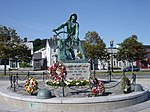Battle of Gloucester (1775)

The Battle of Gloucester was a skirmish fought early in the American Revolutionary War at Gloucester, Massachusetts on August 8 or 9, 1775. Royal Navy Captain John Linzee, commanding the sloop-of-war HMS Falcon, spotted two schooners that were returning from the West Indies. After capturing one schooner, Linzee chased the second one into Gloucester Harbor, where it was grounded. The townspeople called out their militia, captured British seamen sent to seize the grounded schooner, and recovered the captured ship as well. The skirmish was one of a series of actions that prompted a retaliatory expedition by Royal Navy Captain Henry Mowat in October 1775. The major event of his cruise, the Burning of Falmouth, was cited by the Second Continental Congress when it established the Continental Navy.
Excerpt from the Wikipedia article Battle of Gloucester (1775) (License: CC BY-SA 3.0, Authors, Images).Battle of Gloucester (1775)
Fort Square, Gloucester
Geographical coordinates (GPS) Address Nearby Places Show on map
Geographical coordinates (GPS)
| Latitude | Longitude |
|---|---|
| N 42.606422222222 ° | E -70.663719444444 ° |
Address
Fort Square
01930 Gloucester
Massachusetts, United States
Open on Google Maps










